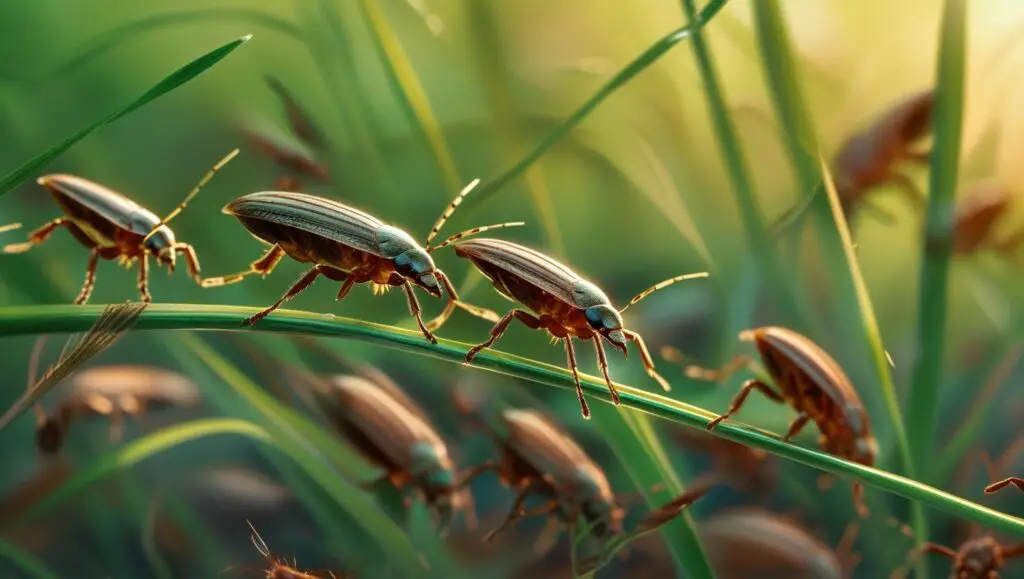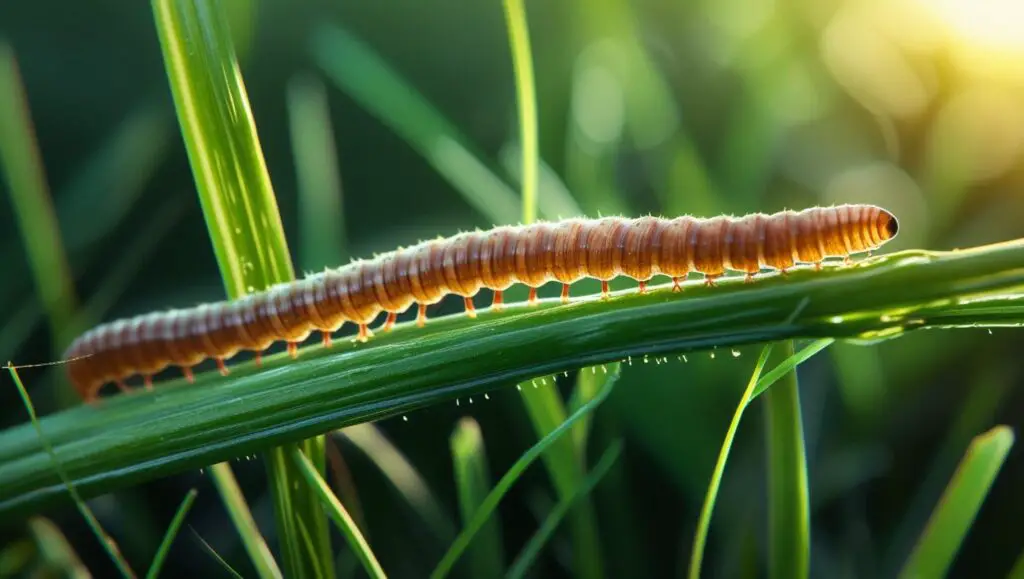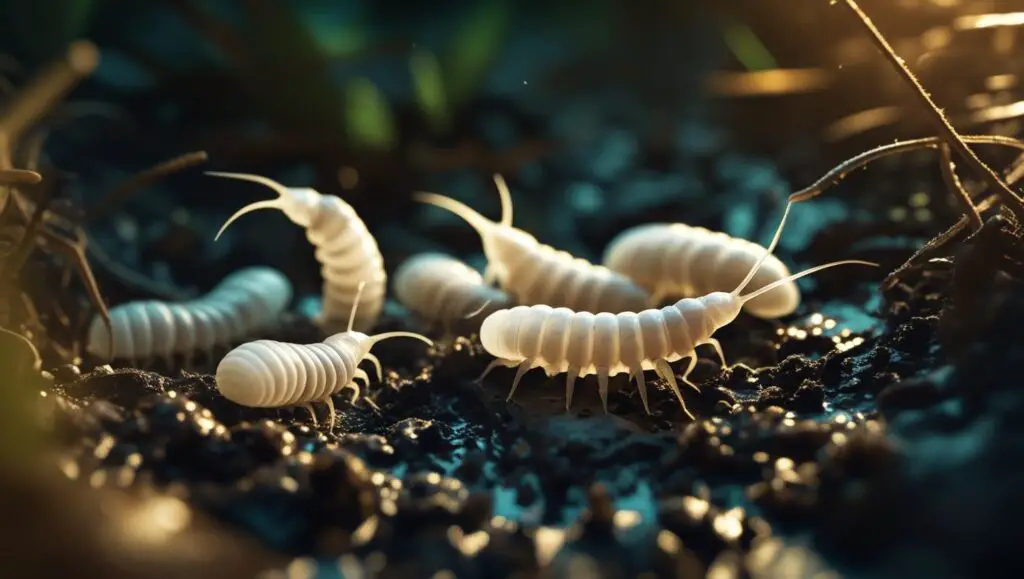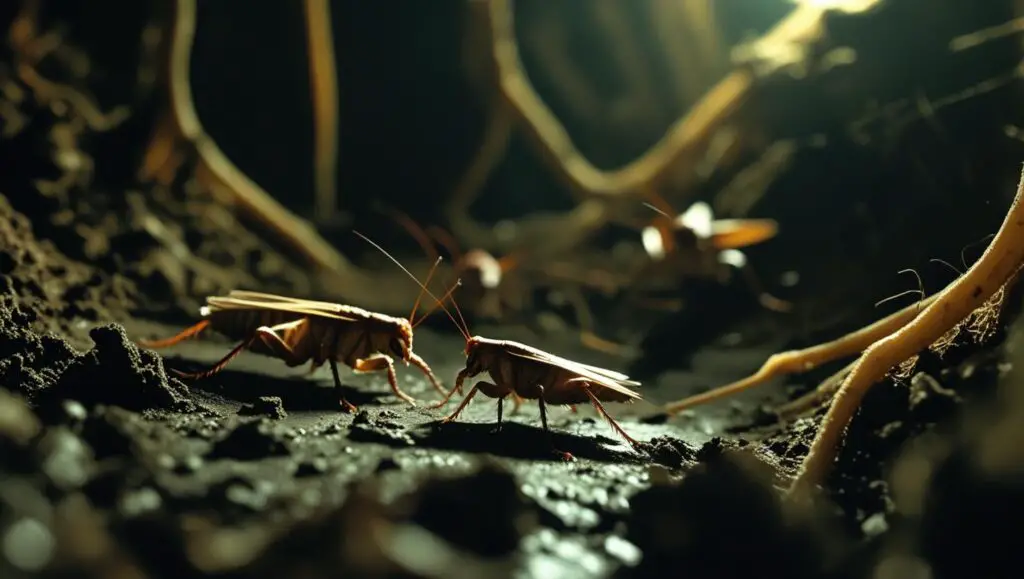Most Common Lawn Pests and 7 Proven Control Methods to Eliminate Them
Lawn pests are insects, grubs, and invertebrates that damage grass through feeding, tunneling, or root destruction. These organisms cause $220 billion in agricultural damage annually worldwide. Common lawn pests include chinch bugs, grubs, billbugs, sod webworms, and cutworms that attack grass blades, roots, and crowns.
What Defines Lawn Pest Species and Their Damage Patterns?
Lawn pests are organisms that feed on grass plants, causing visible damage through 3 primary mechanisms:
- Surface feeding on grass blades and stems
- Root consumption in soil zones
- Tunneling that disrupts plant structure
Examples include chinch bugs (surface feeders), white grubs (root feeders), and mole crickets (tunnelers). Each category creates distinct damage signatures that enable accurate identification.
Which Surface-Feeding Pests Attack Grass Blades Most Frequently?
What are Chinch Bugs and How Do They Damage Lawns?

Chinch bugs are small black insects measuring 1/6 inch long with white wing markings. Adult chinch bugs inject toxins while feeding that prevent grass from absorbing water effectively. Damage appears as circular yellow patches that expand outward, mimicking drought stress.
Peak activity occurs during temperatures above 80°F with low humidity. Chinch bugs overwinter in protected areas and emerge when soil reaches 65°F. EMPIRE® Zoysia grass demonstrates natural resistance to chinch bug infestations.
What are Sod Webworms and How Do They Create Brown Patches?

Sod webworms are caterpillar larvae of white moths that consume grass blades and stems. Adult moths lay eggs during summer months, producing larvae that construct silk-lined tunnels in thatch layers. Damage appears as irregular brown patches with green fecal pellets present.
Larvae feed primarily at night, hiding in thatch during daylight hours. Optimal control occurs with Spinosad-based insecticides applied during late afternoon feeding periods. Maintaining grass height between 3-4 inches reduces webworm damage by 40%.
What are Billbugs and How Do They Destroy Grass Crowns?

Billbugs are weevils measuring 1/4 to 1/2 inch long with distinctive snout-like rostrums. Adult billbugs chew holes in grass stems, creating sawdust-like frass. Larvae feed on grass roots and crowns, causing dead patches that lift easily from soil.
Billbugs emerge when soil temperatures reach 65-70°F during spring months. Peak adult activity occurs during late spring and early summer. Deep, infrequent watering promotes root health and reduces billbug damage susceptibility.
Which Root-Zone Pests Cause the Most Extensive Lawn Damage?
What are White Grubs and How Do They Destroy Grass Roots?

White grubs are C-shaped larvae of scarab beetles that feed exclusively on grass roots. Major species include Japanese beetle grubs, masked chafer grubs, and June beetle grubs. Grubs measure 1/2 to 1 inch long with brown heads and white bodies.
Damage appears as brown patches that feel spongy and lift like carpet due to root destruction. Peak damage occurs during late summer when grubs reach maximum size. Birds, skunks, and raccoons digging in lawns indicate grub presence.
Adult beetles emerge in early summer, mate, and lay eggs in soil. Eggs hatch in mid-summer, producing larvae that feed through fall before overwintering. Preventive treatments applied in early summer provide 90% control effectiveness.
What are Cutworms and How Do They Cut Grass at Soil Level?

Cutworms are moth larvae that cut grass plants at soil level during nighttime feeding. Common species include black cutworms, variegated cutworms, and armyworms. Damage appears as circular dead spots ranging from 2 inches to 3 feet in diameter.
Cutworms hide in soil cracks during daylight hours and emerge at night to feed. Fresh damage shows clean-cut grass stems at soil level. Larvae remain in the same area throughout development, gradually expanding damage radius.
What are Mole Crickets and How Do They Tunnel Through Lawns?

Mole crickets are specialized insects adapted for underground lifestyles that create extensive tunnel systems. These pests measure 1-2 inches long with enlarged front legs for digging. Geographic distribution centers on southeastern United States.
Damage appears as raised ridges in soil from surface tunneling that disrupts grass root systems. Mole crickets feed on grass roots and organic matter. Nocturnal activity and seasonal mating flights help identify infestations.
Beneficial nematodes provide effective biological control by parasitizing mole cricket nymphs. Adults are attracted to lights during mating flights, enabling early detection and monitoring opportunities.
When Do Seasonal Pest Cycles Peak Throughout the Year?
1. During Spring Pest Emergence (March-May)
Spring pest emergence begins when soil temperatures reach 50-60°F consistently. Peak emergence occurs during April and May for most lawn pest species. Early detection during this period prevents 80% of seasonal damage.
Preventive treatments target pests before population establishment. Soil preparation activities include addressing compaction and improving drainage. Proper fertilization provides nutrients for vigorous grass growth without attracting pests.
2. During Summer Peak Activity (June-August)
Summer represents peak activity for 75% of lawn pest species. Hot, dry conditions trigger rapid reproduction and feeding activity. Weekly monitoring detects pest presence before populations reach damage thresholds.
Heat stress makes grass most vulnerable to pest damage. Intervention timing becomes critical as pest populations explode rapidly. Early intervention provides better results with lower environmental impact.
3. During Fall Preparation (September-November)
Fall activities focus on reducing pest overwintering sites and preparing lawns for winter. Thatch removal eliminates habitat for overwintering pests. Fall represents optimal timing for overseeding damaged areas.
Soil treatments during fall target pest species that overwinter in soil. Strong root systems developed during fall help grass resist pest attack the following spring.
4. During Winter Months (December-February)
Winter provides opportunities for strategy development and preparation. Equipment maintenance ensures tools function properly when needed. Educational activities include researching new pest management techniques.
Planning activities include developing integrated management strategies and scheduling preventive treatments. Winter preparation establishes foundation for successful pest management.
How Do Identification Methods Accurately Diagnose Pest Problems?
1. Visual Diagnosis Techniques Identify Pest Damage
Visual diagnosis requires understanding damage patterns, timing, and associated evidence. Circular patterns indicate grub damage, while irregular patches suggest surface-feeding pests. Linear damage patterns often indicate disease problems.
Pest evidence includes frass (insect droppings), shed skins, egg masses, and live specimens. Soil excavation in damaged areas reveals larvae and soil-dwelling pests. Proper identification guides distinguish between similar species.
2. Monitoring Equipment Detects Pest Presence
Pheromone traps detect adult stages of specific pests, providing early warning of infestations. Soil thermometers predict pest emergence based on temperature thresholds. Magnification tools enable accurate identification of small pests.
Laboratory services provide definitive identification of difficult specimens. Extension services offer pest identification assistance and local control recommendations.
3. Professional Diagnosis Services Provide Expert Analysis
Professional diagnosis addresses complex pest problems and unusual symptoms. Sample collection techniques vary by pest type but require proper handling and labeling. University extension services provide expert advice and diagnostic services.
Certified applicators offer professional management when problems exceed homeowner capabilities. Research institutions develop new management techniques and improve existing methods.
Which 7 Control Methods Provide the Most Effective Lawn Pest Management?
1. Cultural Control Methods Form the Foundation of Pest Management
Cultural control methods create conditions that favor healthy grass while reducing pest establishment. Proper mowing height varies by grass type but removes no more than 1/3 of blade length. Sharp mower blades create clean cuts that heal quickly.
Irrigation management provides adequate moisture while avoiding pest-favorable conditions. Deep, infrequent watering encourages root growth and reduces surface moisture. Soil health improvements include addressing compaction and maintaining proper pH levels.
2. Biological Control Options Use Natural Enemies
Biological control utilizes natural enemies to suppress pest populations below damage thresholds. Beneficial insects including predators and parasitic wasps maintain pest control when habitat exists. Beneficial nematodes target specific pest species with minimal environmental impact.
Microbial treatments include bacteria, fungi, and viruses that attack specific pests. Habitat enhancement creates conditions supporting beneficial organisms while reducing pest suitability.
3. Chemical Control Approaches Target Specific Pests
Chemical control serves as targeted tool within integrated management programs. Product selection requires understanding target pests, application timing, and environmental considerations. Application timing affects both effectiveness and environmental impact.
Resistance management involves using multiple control methods and rotating between chemical classes. Safety protocols protect applicators and environment through proper equipment and techniques.
4. Preventive Treatments Stop Pest Establishment
Preventive treatments target pests before damage occurs. Soil applications in early summer prevent grub establishment with 90% effectiveness. Timing based on soil temperature and pest biology optimizes prevention success.
Surface treatments target adult pests before egg-laying begins. Preventive approaches cost 60% less than curative treatments while providing superior results.
5. Curative Treatments Eliminate Established Populations
Curative treatments target active pest populations after establishment. Timing based on pest life cycles maximizes treatment effectiveness. Thorough application coverage ensures contact with target pests.
Soil-incorporated treatments reach root-feeding pests in soil zones. Surface treatments contact above-ground pests during active feeding periods.
6. Integrated Pest Management Combines Multiple Approaches
Integrated Pest Management (IPM) combines cultural, biological, and chemical methods for sustainable solutions. Cultural practices form the foundation by creating unfavorable pest conditions. Biological control provides ongoing suppression through natural enemies.
Chemical control addresses situations where other methods prove insufficient. Monitoring determines when intervention becomes necessary based on pest thresholds.
7. Long-term Strategies Maintain Pest Resistance
Long-term strategies focus on maintaining healthy lawns that naturally resist pest establishment. Grass selection based on local conditions and pest resistance provides foundational protection. Soil management maintains proper pH and beneficial organism populations.
Ecosystem balance supports beneficial organisms while reducing pest pressure. Adaptive management adjusts strategies based on monitoring results and changing conditions.
What Are 5 Advanced Pest Management Considerations for Lawn?
1. Climate Change
Climate change shifts pest ranges through altered temperature and precipitation patterns. Previously non-problematic species become significant pests as conditions change. Extended growing seasons affect pest life cycles and damage timing.
Adaptation strategies involve selecting resilient grass varieties and implementing water conservation. Flexible management approaches adjust to changing environmental conditions.
2. Monitoring Emerging Pest Threats
Invasive species continue expanding ranges and establishing in new areas. Early detection programs prevent establishment of new pest species. Resistance evolution requires ongoing monitoring and development of new control methods.
New control technologies include precision application systems and biotechnology-based solutions. These innovations offer opportunities for targeted and effective management.
3. Sustainable Approaches Reduce Chemical Dependency
Sustainable approaches minimize chemical dependency while maintaining acceptable lawn quality. Reduced input systems emphasize prevention, biological control, and cultural practices. Native alternatives provide attractive landscapes with natural pest resistance.
Ecosystem services from diverse landscapes include pest control, pollinator habitat, and water quality protection. Community-wide benefits extend beyond individual properties.
4. Resources That Support Effective Pest Management
Field guides provide detailed identification information for regional pest species. Online resources include interactive identification keys and image databases. Mobile applications offer instant access to identification and control information.
Extension services provide expert advice, diagnostic services, and educational resources. Professional applicators offer services when problems exceed homeowner capabilities.
5. Future Developments That Improve Lawn Pest Control
Future pest management involves continued development of targeted, environmentally friendly methods. Improved understanding of pest biology and ecology guides new approaches. Biotechnology offers opportunities for pest-resistant grass varieties.
Precision agriculture techniques enable site-specific treatments that reduce environmental impact. Research institutions develop new methods and improve existing techniques.
Summary
Effective lawn pest management requires a comprehensive approach that combines prevention, monitoring, and targeted control measures. The most successful strategies emphasize maintaining healthy lawns that naturally resist pest establishment while using integrated management techniques to address problems when they occur.
Prevention remains the most cost-effective and environmentally sound approach to pest management. Cultural practices that promote grass health, support beneficial organisms, and create unfavorable conditions for pests provide the foundation for long-term success.
Regular monitoring enables early detection and intervention before pest problems become severe. Understanding pest biology, damage patterns, and seasonal timing helps optimize control efforts and reduce the need for intensive treatments.
Integrated management approaches that combine cultural, biological, and chemical control methods provide the most effective and sustainable pest management results. These strategies address both immediate problems and long-term prevention while minimizing environmental impact.
The future of lawn pest management will likely involve continued development of targeted, environmentally friendly control methods combined with improved understanding of pest biology and ecology. Climate change will create new challenges and opportunities, requiring adaptive management approaches that can respond to changing conditions.
Success in lawn pest management depends on patience, persistence, and willingness to learn from both successes and failures. Each lawn presents unique challenges, and effective management requires tailoring general principles to specific conditions and pest pressures.
Building resilient, healthy lawns that can withstand pest pressure while providing attractive, functional landscapes represents the ultimate goal of integrated pest management. This approach benefits not only individual property owners but also contributes to broader environmental health and sustainability goals.
